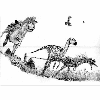AVIALAE
CLASSIFICATION
Animalia: Vertebrata: Tetrapoda: Sauropsida: Archosauromorpha:
Ornithodira: Dinosauria: Theropoda: Tetanurae: Coelurosauria
CLADOGRAM:
--Avialae Gauthier, 1986 sensu Padian, 1997 == {Neornithes > Deinonychus}
| INCERTAE SEDIS:
| cf. Archaeopteryx (partial humerus) -- Cenomanian -- Romania
| ?Wyleyia
`--Aves Linnaeus sensu Chiappe "birds" == {Archaeopteryx + Neornithes} =Avialae sensu Gauthier, 1986
| INCERTAE SEDIS:
| unnamed "Archaeoraptor" form (forepart of skeleton with integument impressions) -- middle Barremian -- China
|--Archaeopterygiformes =Archaeornithes
| `--Archaeopteryx
`--+ == {Neornithes > Archaeopteryx} =Ornithurae sensu Gauthier, 1986
| INCERTAE SEDIS:
| ?Hulsanpes
|?-Yandangornis
`--Pygostylia "pygostyles ("Parson's noses")" == {Confuciusornis + Neornithes}
| INCERTAE SEDIS:
| indeterminate material (PO 4821: proximal coracoid) -- Coniacian -- Uzbekistan
| Catenoleimus
|--Confuciusornithidae
| |--Changchengornis
| |--Confuciusornis
| `--Proornis
`--+ INCERTAE SEDIS:
| Abavornis
| Explorornis
| Holbotia
| Incolornis
| Zhyraornithidae
| `--Zhyraornis
|?-Jibeinia
|?-Longipteryx
|?-Noguerornis
|?-Protopteryx
`--Ornithothoraces "modern bird chests" == {Iberomesornis + Neornithes}
| INCERTAE SEDIS:
| Platanavis
|?-Vorona
|--Euornithes Sereno, 1998 "true birds" == {Neornithes > Sinornis} =Ornithurae sensu Feduccia
| | INCERTAE SEDIS:
| | ?Kuszholia
| | Gansuiformes
| | `--Gansus
| | Ambiortiformes
| | |?-Otogornis
| | `--Ambiortus
| | Patagopterygiformes
| | |--Patagopteryx
| | `?-Gargantuavis
| | Chaoyangiiformes
| | |--Chaoyangiidae
| | | `--Chaoyangia
| | `?-Songlingornithidae
| | `--Songlingornis
| |?-Liaoningornis
| |?-Yanornis
| |?-Yixianornis
| `---->Ornithurae
`---->Enantiornithes
ALTERNATE CLADOGRAM:
--Avialae
`--Aves
|--Metornithes
`--Archaeornithes "ancient birds" =Archaeopterygiformes
|--Unenlagia
`--Archaeopterygidae
|--Archaeopteryx
`--Rahonavis
ALTERNATE CLADOGRAM:
--Avialae
`--Metornithes
|--Alvarezsauria
`--Aves
|--Archaeopteryx
`--Pygostylia
ALTERNATE CLADOGRAM:
--Avialae
|--Aves
`---->Troodontidae
ALTERNATE CLADOGRAM:
--Aves =Pygostylia
|--Archaeornithes
| |--Archaeopteryx
| `--Confuciusornithidae
`--+ =Ornithothoraces sensu Chatterjee
|--Protoavis
`--Ornithothoraces =Pygostylia sensu Chatterjee
ALTERNATE CLADOGRAM:
—Aves =Ornithothoraces =Pygostylia
|–Ornithurae
`–Saururae “lizard tails” == {Archaeopteryx > Neornithes} =Sauriurae
|–Archaeopteryx
|–Caudipteryx
|–Protarchaeopteryx
|–Yandangornis
`–Enantiornithes
ESSAY
| ORIGINS:Birds evolved from small, possibly “sickle-clawed” coelurosaurs probably sometime during the Jurassic (some have suggested the Triassic), as did their close relatives the deinonychosaurs. The earliest known definite bird is the European Archaeopteryx, a small flying predator from the Late Jurassic. The North American Protoavis has been interpreted as a Late Triassic bird that is more “advanced” than Archaeopteryx, but few dinosaur/bird researchers agree with this at present. A DVANCED FORMS:Pygostylian birds are characterized by a pygostyle, a fusion of the vertebrae at the end of the tail. This trait seems to have evolved convergently in at least one oviraptorosaur (Nomingia) and at least one megalancosaurid (Drepanosaurus). Ornithothoracean birds, a large subset of pygostylians that includes modern birds, have a “modern-style” thorax and an alula, or “bastard wing” — a group of feathers associated with the first finger that aids maneuverability in flight. F ROM THE T REES OR F ROM THE GROUND?:Unlike the other two groups of flying vertebrates, pterosaurs and bats, the hindlimbs of birds are not in any way coupled with the wings, and remain free for running. Due to this and other pieces of evidence, some dinosaur researchers argue that birds did not evolve from a tree-dwelling ancestor, as the other groups are thought to have. Recent studies suggest that Archaeopteryx could run fast enough to take off from the ground, bolstering this hypothesis, commonly known as the “Ground Up” hypothesis. But many disagree with this idea, arguing that flight in birds evolved as it seems to have in bats and pterosaurs — from the “Trees Down”. They hold that bird ancestors were scansorial coelurosaurs which leaped from tree to tree, then evolved into gliders, and from there to fliers. The facts that Archaeopteryx has claws sharply recurved for climbing and that its first toe is reversed for perching support this idea. As of now, the fossil evidence does not clearly favor either the “Trees Down” or “Ground Up” hypotheses of the evolution of flight in birds. A N O PPOSING VIEW:The hypothesis that birds descended from dinosaurs has been around for a long time. Thomas Huxley (a.k.a. “Darwin’s bulldog”) proposed such a relationship based on similarities between Archaeopteryx and dinosaurs. This view was dismissed by Gerhard Heilmann, who noted that dinosaurs lack clavicles, which are not only present in birds but fused to form the furcula, or “wishbone”. Heilmann’s suggestion that birds and dinosaurs descended separately from “thecodont” (basal archosaurian) stock held fast for most of the 1900’s. Heilmann’s view was finally dispelled by the discovery that some theropod dinosaur fossils (such as those of Segisaurus) do in fact have clavicles. In tetanuran forms (such as Velociraptor, oviraptorids, allosaurids), they are even fused to form furculae. These elements had often been mistaken for rib fragments. Additionally, clavicles are reduced or missing in some modern birds, and were likely so for many other theropods. A more recent objection to the dinosaur-bird link is the claim that embryological evidence shows the digits in the hands of modern birds to be II-III-IV, not I-II-III as in coelurosaurs and other tetanurans. In fact, the story may be quite a bit more complicated. It is not certain that the element that has been interpreted as a vestigial digit I is in fact digit I. Furthermore, other studies show that frame shift can cause some birds to have digits aligned differently than in other birds, even with the same species. Opponents of the dinosaurian theory of bird origins have yet to propose an explicit alternate theory, generally stating that birds evolved from basal archosauromorphs of some kind. They also have yet to explain why such an enormous degree of convergence would appear between birds and terrestrial theropods when they represent separate niches. |
IMAGES

| Two tiny trespassing neotheropods take flight to escape territorial Tyrannosaurus rex. Ornithothoraceans soar in the background. |